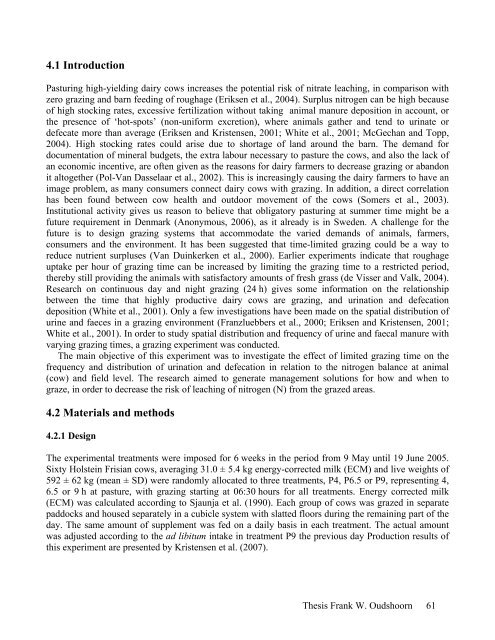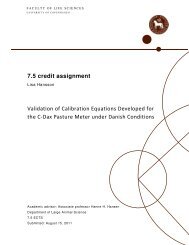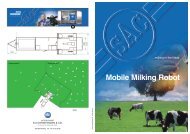Innovative Technology and Sustainable Development of Organic - 1.
Innovative Technology and Sustainable Development of Organic - 1.
Innovative Technology and Sustainable Development of Organic - 1.
You also want an ePaper? Increase the reach of your titles
YUMPU automatically turns print PDFs into web optimized ePapers that Google loves.
4.1 Introduction<br />
Pasturing high-yielding dairy cows increases the potential risk <strong>of</strong> nitrate leaching, in comparison with<br />
zero grazing <strong>and</strong> barn feeding <strong>of</strong> roughage (Eriksen et al., 2004). Surplus nitrogen can be high because<br />
<strong>of</strong> high stocking rates, excessive fertilization without taking animal manure deposition in account, or<br />
the presence <strong>of</strong> ‘hot-spots’ (non-uniform excretion), where animals gather <strong>and</strong> tend to urinate or<br />
defecate more than average (Eriksen <strong>and</strong> Kristensen, 2001; White et al., 2001; McGechan <strong>and</strong> Topp,<br />
2004). High stocking rates could arise due to shortage <strong>of</strong> l<strong>and</strong> around the barn. The dem<strong>and</strong> for<br />
documentation <strong>of</strong> mineral budgets, the extra labour necessary to pasture the cows, <strong>and</strong> also the lack <strong>of</strong><br />
an economic incentive, are <strong>of</strong>ten given as the reasons for dairy farmers to decrease grazing or ab<strong>and</strong>on<br />
it altogether (Pol-Van Dasselaar et al., 2002). This is increasingly causing the dairy farmers to have an<br />
image problem, as many consumers connect dairy cows with grazing. In addition, a direct correlation<br />
has been found between cow health <strong>and</strong> outdoor movement <strong>of</strong> the cows (Somers et al., 2003).<br />
Institutional activity gives us reason to believe that obligatory pasturing at summer time might be a<br />
future requirement in Denmark (Anonymous, 2006), as it already is in Sweden. A challenge for the<br />
future is to design grazing systems that accommodate the varied dem<strong>and</strong>s <strong>of</strong> animals, farmers,<br />
consumers <strong>and</strong> the environment. It has been suggested that time-limited grazing could be a way to<br />
reduce nutrient surpluses (Van Duinkerken et al., 2000). Earlier experiments indicate that roughage<br />
uptake per hour <strong>of</strong> grazing time can be increased by limiting the grazing time to a restricted period,<br />
thereby still providing the animals with satisfactory amounts <strong>of</strong> fresh grass (de Visser <strong>and</strong> Valk, 2004).<br />
Research on continuous day <strong>and</strong> night grazing (24 h) gives some information on the relationship<br />
between the time that highly productive dairy cows are grazing, <strong>and</strong> urination <strong>and</strong> defecation<br />
deposition (White et al., 2001). Only a few investigations have been made on the spatial distribution <strong>of</strong><br />
urine <strong>and</strong> faeces in a grazing environment (Franzluebbers et al., 2000; Eriksen <strong>and</strong> Kristensen, 2001;<br />
White et al., 2001). In order to study spatial distribution <strong>and</strong> frequency <strong>of</strong> urine <strong>and</strong> faecal manure with<br />
varying grazing times, a grazing experiment was conducted.<br />
The main objective <strong>of</strong> this experiment was to investigate the effect <strong>of</strong> limited grazing time on the<br />
frequency <strong>and</strong> distribution <strong>of</strong> urination <strong>and</strong> defecation in relation to the nitrogen balance at animal<br />
(cow) <strong>and</strong> field level. The research aimed to generate management solutions for how <strong>and</strong> when to<br />
graze, in order to decrease the risk <strong>of</strong> leaching <strong>of</strong> nitrogen (N) from the grazed areas.<br />
4.2 Materials <strong>and</strong> methods<br />
4.2.1 Design<br />
The experimental treatments were imposed for 6 weeks in the period from 9 May until 19 June 2005.<br />
Sixty Holstein Frisian cows, averaging 3<strong>1.</strong>0 ± 5.4 kg energy-corrected milk (ECM) <strong>and</strong> live weights <strong>of</strong><br />
592 ± 62 kg (mean ± SD) were r<strong>and</strong>omly allocated to three treatments, P4, P6.5 or P9, representing 4,<br />
6.5 or 9 h at pasture, with grazing starting at 06:30 hours for all treatments. Energy corrected milk<br />
(ECM) was calculated according to Sjaunja et al. (1990). Each group <strong>of</strong> cows was grazed in separate<br />
paddocks <strong>and</strong> housed separately in a cubicle system with slatted floors during the remaining part <strong>of</strong> the<br />
day. The same amount <strong>of</strong> supplement was fed on a daily basis in each treatment. The actual amount<br />
was adjusted according to the ad libitum intake in treatment P9 the previous day Production results <strong>of</strong><br />
this experiment are presented by Kristensen et al. (2007).<br />
Thesis Frank W. Oudshoorn 61




